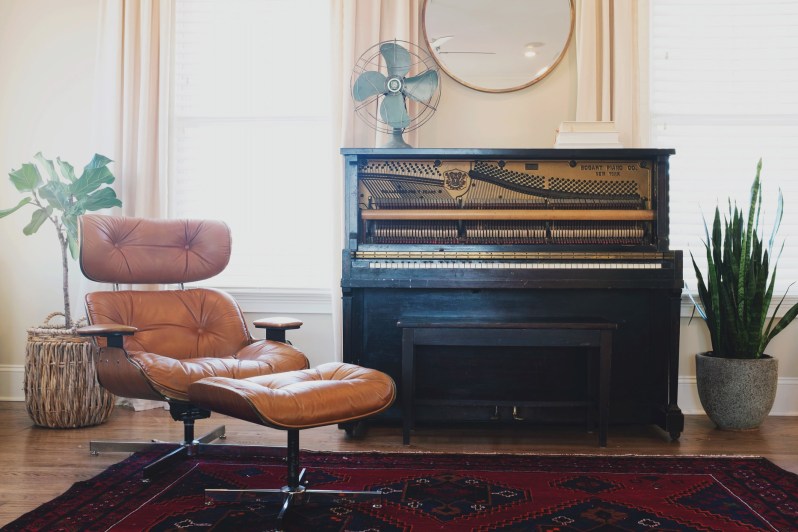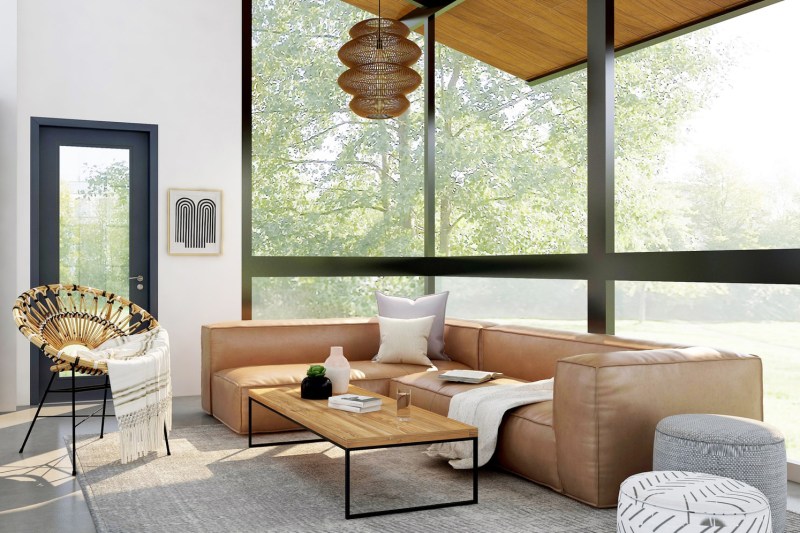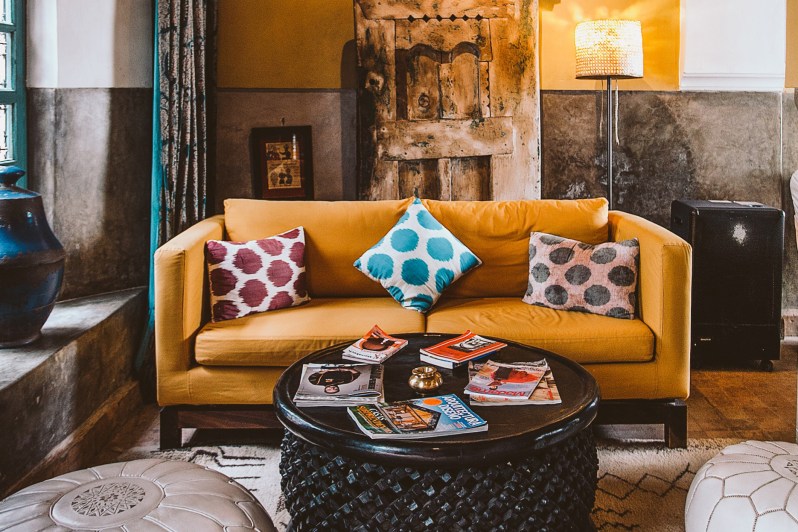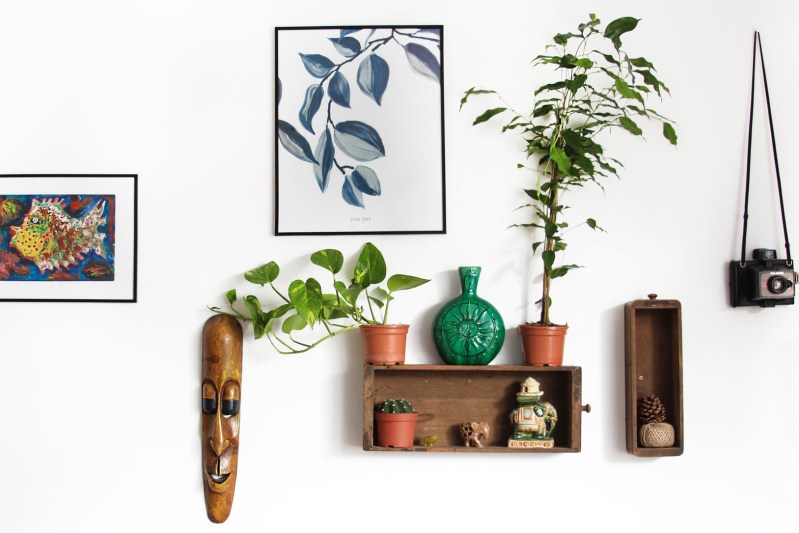Do you suffer from wanderlust? Have a collection of mementos from your world travels? Love the look of well-worn rugs, the thumbed-through pages of an old book, and the sagging seat of your favorite chair? Then “global” is the interior design style for you. It’s all about texture, culture, and comfort. By gathering inspiration from around the world, you can satisfy that wanderlust without ever leaving home.
Related Guides
Principles

Global as an interior design style is exactly what it sounds like — a home filled with objects, patterns, textures, and colors inspired by cultures from around the world. For travelers, history buffs, and nomads at heart, global is a reflection of one’s love and appreciation for the skill and craftsmanship that goes into creating each piece, whether it’s a handmade woven rug or a piece of hand-carved furniture. It’s a way to remember favorite destinations, display your family’s culture and history, or it can act as an aspirational look for places you hope to explore someday.
While global has often been associated with Ernest Hemingway and the signature look that made up his Key West home, it can be more than that. While Hemingway curated mostly dark, heavy wood furniture, this style can also be bright and airy depending on what part of the world inspires you most. Countries like Norway and Portugal feature interiors that are crisp and welcoming, thanks to monotone color palettes. On the other hand, you can go colorfully bold by drawing on inspiration from Morocco or India. Or head to the water by incorporating Mediterranean vibes or the tropical colors of the Pacific islands or the Caribbean.
There are no hard and fast rules for global décor. It is whatever you make it. Whereas other styles have a clear theme to build around, this look is beautifully and proudly eclectic. The key is to honor the cultures that inspire you and slowly build the design in a thoughtful way.
Architecture

Global is similar to the maximalism trend in that it did not spring from a specific architectural style. Instead, it grew organically in the early 1900s as world travelers brought home pieces from their explorations. This included everything from furniture to textiles, and often a single room of the home was carved out to become a miniature museum. Today, pieces can be sourced straight from artisans around the world without ever having to get off of the couch.
The unique part about global style is that you can make it your own. There are no rules to curating a worldly home and, because it is not connected to a single architectural movement, this style will work in almost any space. Whatever your home looks like on the outside — minimalist or maximalist, classic architecture or mid-century modern — it all can be outfitted with a global-inspired interior.
Like maximalism, global doesn’t have to stick to one type of architectural style, but it is enhanced by incorporating unique architectural elements into your space. Love the look of the Moorish horseshoe arch? You can install corbels in doorways to mimic that design. Or maybe you like the intricate jali wrought iron of classic Indian furniture. This makes for visually intriguing staircase railings.
For an authentic worldly look, exposed ceiling beams are seen in everything from English Tudors to Japanese tea houses to Spanish Mission homes. It’s an architectural element that can be faked if your space doesn’t already have this feature. Just grab some “ornamental” beams from a place like Lowe’s, and you can have a brand-new look in a weekend.
If there is one space every global-inspired home should have, it’s a library. After all, you need a place to keep your travel guides, coffee table books, and photos from your adventures. This doesn’t have to be a whole room, although kudos to you if you have the space! A home library can be as simple as a bookcase, a comfy armchair, a lamp, and a side table. The library is an essential spot for the global-minded gentleman — it’s the contemplation place to remember past travels and plan future expeditions. Bonus points if you can fit in a bar cart, so a tumbler of bourbon is always close at hand.
Furniture, Colors, and Patterns

Global is such an appealing style because it is open to interpretation. When you think of your favorite spots around the world, do you imagine azure seas, palm trees, and white sand beaches? Go with bright coastal colors, woven rattan seating, and natural fiber area rugs. Do you think of the snow-capped mountains, deep green forests, and rough waters of Scandinavia? Bring in plush area rugs, light wood furniture, and incorporate a monotone color palette of whites and beiges. This can be a bright and welcoming style or dark and cozy. It’s all up to you.
Color palettes can be tricky to get right, especially with a style like global that has no hard rules. The key is building off of a few pieces you already have. If you found the perfect Moroccan tiles to use as a fireplace surround, pull those colors to use as a basis for selecting accessory décor items like throw pillows, drapes, and artwork.
Some design styles work best when a single species of wood is used throughout the space. For people who want more variety, global loves mixed timber. Get yourself a mahogany writing desk in a Hemingway style, some bamboo bookshelves, and an oak coffee table. While you can shop for brand new pieces, part of the fun of this style is hunting for that one-of-a-kind find, so take your time to select the right pieces that you’ll love for years to come.
Patterns are a great way to add visual interest to your space and further enhance the carefully cultivated look of global style. Many cultures tell stories through their patterns. The Japanese have a rich history of using tapestries to share their fables and legends. The Portuguese use the blue and white azulejo tiles to tell their history, and Native American tribes share their religion through woven rugs, blankets, and baskets. When incorporating these pieces, go straight to the source to support the artisans who are telling their own stories.
Furniture is key to perfecting the global look. No standard shelves from Ikea, this is a chance to curate one-of-a-kind pieces from unique shops. Thankfully the internet means you don’t need to travel to Africa to get a woven tapestry direct from the maker. And no more weekends at antique markets looking for the perfect travel trunk to turn into a coffee table.
Global design might seem hard to put together because of the endless possibilities, but the key is to build off of the focal point in each room. This is typically going to be the largest piece of furniture in the room, like the dining table, or a statement piece such as a sculpture or painting. Look at the colors, patterns, and texture of that focal piece and go from there. As for where to source the pieces, that’s easier than you think too. It’s all there at the touch of a button if you know where to look.
Where to Shop
With a wide range of options to choose from, global-inspired pieces can be found in surprising places. From nationwide box stores to online specialty boutiques that source directly from the makers, global is one design style that can be put together on any budget.
Target
It’s no secret that Target has a cult following amongst millennial moms who go crazy for their home décor, and that’s for good reason. The chain has seriously stepped up its style game in the last decade, offering items that are on trend with good quality and affordable prices. This may not be the place to get large furniture pieces, but it is the best spot for those stylish little tchotchkes that can help finish off a space. Scroll through the “Decorative Objects” section to find woven baskets, nature-inspired sculptures, and a wide variety of globes (is it really “global” style if you don’t have an actual globe on display?).
Novica
Novica isn’t so much a store to shop but rather a single place that brings artisans directly to consumers. Since its founding in 1999, the company has sent over $108 million dollars directly to makers in every corner of the world. You can find just about anything for your home at Novica. Part of the fun of exploring this site is getting to learn the story of the person who made the pieces you are purchasing. The site makes it easy to shop by region of the world, and from there, you can narrow down exactly what you are looking for, whether it’s a lamp, a piece of furniture, or throw pillows.
54kibo
Just like any other design trend, global style has evolved over the years. In the early days of the movement, African art was at the forefront. In the middle of the 20th century, Asian themes became more popular, followed by Scandinavian décor in the late 1990s and early 2000s. Today, it’s once again all about Africa. 54kibo was developed with this in mind. Founded by Ghana-born, South African-raised Nana Quagraine, the company is similar to Novica, sourcing hand-crafted pieces direct from artisans. Pieces from 54kibo are contemporary, fresh, and bold. And just like at Novica, 54kibo includes an artist bio so you can read about the real person behind each piece.
Froy
Froy may be widely known for its striking line of mid-century modern furnishings, but the company’s area rugs are perfect for a global style space. Offering everything from Moroccan to Ikat Indian pieces, the high-end quality Froy has built its reputation on extends to these rugs.



